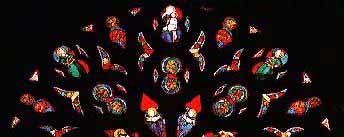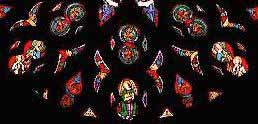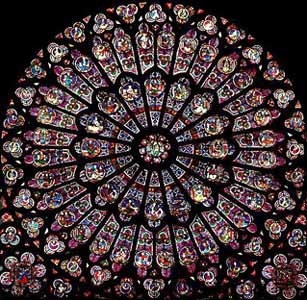
 Rose
Windows are the apex of stained glass development. These circular
mandalas radiate with sacred medieval imagery. The primary subject of
the great roses is the Virgin and Child. Many other themes are featured,
such as the life of Christ, the apostles and tales from the Bible. Less
common features are medieval heraldry and symbols of the seasons or the
astrological zodiac. Rose
Windows are the apex of stained glass development. These circular
mandalas radiate with sacred medieval imagery. The primary subject of
the great roses is the Virgin and Child. Many other themes are featured,
such as the life of Christ, the apostles and tales from the Bible. Less
common features are medieval heraldry and symbols of the seasons or the
astrological zodiac.
 The
great roses which we associate with cathedrals today, did not
truly flourish until the mid thirteenth century. The ability to incorporate
such large glass works into the walls became possible only after structural
innovations within vaulting. Transferring the task of weight
support to the vaults and buttresses allowed the solid planes to be
partitioned for the entry of light. The following innovations are
still some of the most impressive works of European art and culture. The
great roses which we associate with cathedrals today, did not
truly flourish until the mid thirteenth century. The ability to incorporate
such large glass works into the walls became possible only after structural
innovations within vaulting. Transferring the task of weight
support to the vaults and buttresses allowed the solid planes to be
partitioned for the entry of light. The following innovations are
still some of the most impressive works of European art and culture.
| Illuminated Manuscripts
share such elements with rose windows as: the use of elaborate
imagery; symbols; vibrant colors; biblical figures; saints and
allegory. |
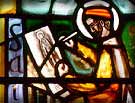 |
 While
stained glass windows are to be found wherever the gothic style
manifested, the finest exist in France. While the works of Paris and
Chartres are often singled out, lesser known but equally beautiful
rose windows are found throughout the country, at such sites as Rheims,
Laon, Bourges, Amiens Soissons and others. While
stained glass windows are to be found wherever the gothic style
manifested, the finest exist in France. While the works of Paris and
Chartres are often singled out, lesser known but equally beautiful
rose windows are found throughout the country, at such sites as Rheims,
Laon, Bourges, Amiens Soissons and others. |
 The
vibrancy of an original window of the Gothic age is the feature which differentiates
it from glass work of a later era. Prior to the middle of the sixteenth century,
windows were illustrated with glass pieces of a solid color. Realistic likenesses
were achieved through crafted combinations of hues. By the Renaissance, many of
the medieval artistic forms had been abandoned or replaced. Various techniques
of painted glass replaced the elder craft and only rarely was true stained glass
used in the following centuries. The
vibrancy of an original window of the Gothic age is the feature which differentiates
it from glass work of a later era. Prior to the middle of the sixteenth century,
windows were illustrated with glass pieces of a solid color. Realistic likenesses
were achieved through crafted combinations of hues. By the Renaissance, many of
the medieval artistic forms had been abandoned or replaced. Various techniques
of painted glass replaced the elder craft and only rarely was true stained glass
used in the following centuries.
 During
the nineteenth century a renewed interest developed for the arts
of the medieval period, particularly those forms related to the
Gothic churches and cathedrals. Great efforts were invested to
restore earlier buildings and works, and many new structures,
both religious and secular were modeled on a Neo Gothic ideal. During
the nineteenth century a renewed interest developed for the arts
of the medieval period, particularly those forms related to the
Gothic churches and cathedrals. Great efforts were invested to
restore earlier buildings and works, and many new structures,
both religious and secular were modeled on a Neo Gothic ideal.
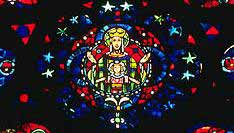
 Enthusiasm
for the Gothic style spread throughout England, Germany, Eastern
Europe and across the Americas. Great labor was invested to recover
the skills and techniques of the original builders, but much had
been lost forever. The modern era has produced countless works
of great beauty, still, the quality of the medieval windows has
not been duplicated. Yet time will tell; many of these wonders
remain to inspire the dreams of future generations. Enthusiasm
for the Gothic style spread throughout England, Germany, Eastern
Europe and across the Americas. Great labor was invested to recover
the skills and techniques of the original builders, but much had
been lost forever. The modern era has produced countless works
of great beauty, still, the quality of the medieval windows has
not been duplicated. Yet time will tell; many of these wonders
remain to inspire the dreams of future generations.
In
the woods in a winter afternoon one will see as readily the origin
of the stained glass window, with which Gothic cathedrals are
adorned, in the colors of the western sky seen through the bare
and crossing branches of the forest.
—Ralph Waldo Emerson
|





